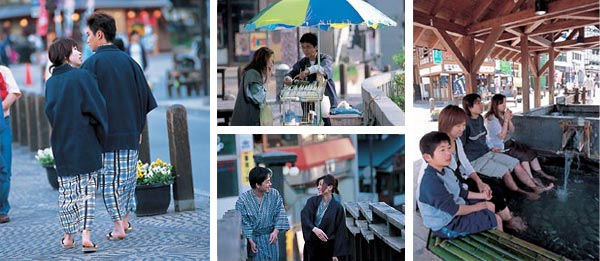|
|
||||||||||||||||||||||||||||
Special Feature*
Japanese spas have evolved into a place to enjoy the baths and also to sample local delicacies and party it up with alcohol and amateur singing. This has become a common leisure activity. When the economy expanded in the 1960s and 70s, large groups would descend on hot springs. The most common tour packages were for company employees and management personnel who came partly to promote better relations among staff. High corporate profits generated an enthusiasm that was expressed by partying at a spa. To accommodate such guests, ryokan as large as a city hotel were built. The new resorts offered the opportunity for workers to get back their energy after working hard to build the economy.
Today, the trend is away from group tours, so ryokan continue to change. The smaller ryokan, the ones that did not keep up with the times by expanding, are back in favor again. Another recent tendency is for ryokan, even the most Japanese in outward appearance, to break with the past by creating their own unique style inside — perhaps adding tables and chairs that look like furnishings at some resort hotel in Bali.
I suppose Japanese spas have continued to evolve through the centuries, adapting to the changing lifestyles of their clientele. Why, after all, should they remain bound by old traditions? Hot springs are for people to enjoy the waters and get benefits from them, and that is surely enough.
We had a relaxing bath before supper, and then returned to our room. Just as we were starting to feel hungry, the maid arrived carrying supper on small zen tables. This meal would make anyone feel good — plenty of wild vegetables and other tasty food from the mountains, a typical meal at a highland spa. We poured saké into each other's sakazuki cups, and watched the sky slip into ever deeper shades of blue.
After supper, we decided to stroll through part of the town. The guests' shoes had been put away at the entrance, and wooden clogs were set out instead. The clickety-clack of clogs is music to the ears. Small groups of people were strolling like we were, each group wearing yukata with colors and designs that were different from those of the other groups. This, I suppose, is because they were staying at different ryokan. The evening breeze from the mountains was a little too cool, so I thought I would take another nice dip in the bath later, at the inn.
When we returned to our room, the zen tables and supper dishes had been taken away and futons were laid out on the floor.I remembered what the landlady had said: "More of our guests these days are young. They seem to find it unusual eating and sleeping on tatami mats."
I am not exactly young, but I too sleep on a bed at home and eat at a dining table. So I found it refreshing to see how, like magic, a single room can be transformed to permit eating and sleeping in the same space. A hot spring resort is a place where even Japanese people can experience the traditional lifestyle.
The weather remained fine the next day. The soft rays of the morning sun came through the bath window, bouncing off the smooth surface of the water. I had gotten out of bed feeling somewhat lethargic, but a soak in the hot water invigorated me from head to toe. I am sure that you too would feel, on such a morning, that a stay at a hot spring is truly worthwhile.
After the dip in the bath, I returned to the room to see the futons put away and breakfast waiting. It seems that taking a bath at a hot spring is the same as exercising just the right amount. I was surprisingly hungry after my bath. The lightly-boiled egg, slowly cooked at the temperature of the hot spring, went down very nicely. Delicious!
|
||||||||||||||||||||||||||||
